In regions where every drop of water counts, mulching stands as one of the most effective strategies for sustainable gardening. As climate patterns shift and water restrictions become more common, understanding how to conserve moisture in your garden isn’t just environmentally responsible—it’s essential for growing success. Mulching techniques can dramatically reduce water loss, especially in hot, arid environments where evaporation rates are high and rainfall is scarce.
This comprehensive guide explores how strategic mulching can transform your gardening experience in dry climates. Whether you’re tending to a vertical garden on a balcony or maximizing a small backyard plot, these water-smart techniques will help you create a thriving garden while minimizing your water footprint. Let’s discover how the simple act of applying the right mulch in the right way can make all the difference in your garden’s resilience and productivity.
The Science of Mulching & Water Retention
Understanding how mulch works to conserve water helps gardeners make informed decisions about which materials to use and how to apply them effectively. The science behind mulching reveals why it’s such a powerful tool for water conservation in arid environments.
How Mulch Reduces Evaporation
Mulch acts as a physical barrier between the soil surface and the atmosphere, dramatically reducing the rate at which water evaporates. In hot, arid climates, bare soil can lose moisture rapidly—sometimes within hours of watering. Studies have shown that a properly applied layer of mulch can reduce evaporation rates by up to 50%, allowing the soil to retain moisture for days longer than unmulched areas.
This moisture-preserving effect works through several mechanisms:
- Blocking direct sunlight from reaching the soil surface
- Reducing air movement across the soil surface that accelerates evaporation
- Creating a humidity zone between the soil and the mulch layer
- Minimizing water runoff by slowing the movement of water, allowing more time for absorption
Soil Temperature Regulation in Extreme Heat
Soil temperature plays a crucial role in plant health and water conservation. In arid regions, unmulched soil can reach temperatures exceeding 100°F (38°C), which not only stresses plant roots but accelerates moisture loss. Mulch provides insulation that moderates these temperature extremes.
Organic mulches like wood chips or straw can reduce soil temperatures by 8-13°F (4-7°C) during the hottest part of the day. This temperature regulation has several benefits:
- Reduces heat stress on plant roots, improving overall plant health
- Slows water movement through the soil, reducing evaporation rates
- Creates more favorable conditions for beneficial soil microorganisms
- Extends the growing season by protecting plants from temperature fluctuations
Impact on Soil Structure and Root Health
Beyond the immediate effects on water conservation, mulching improves soil structure over time, especially when organic materials are used. As organic mulches break down, they contribute valuable organic matter to the soil, enhancing its ability to retain moisture.
This improvement in soil structure creates a positive cycle for water conservation:
- Increased organic matter improves soil’s water-holding capacity
- Better soil structure allows water to penetrate more deeply, reducing runoff
- Enhanced microbial activity creates channels in the soil that improve water infiltration
- Healthier root systems develop that can access water more efficiently
In arid climate gardens, these soil improvements can significantly reduce irrigation needs over time, sometimes by as much as 30% compared to unmulched gardens with poor soil structure.
Want to learn more about soil health?
Download our free guide to building healthy soil in arid climates and discover how to create the perfect foundation for water-efficient gardening.
Best Mulching Materials for Dry Climates
Choosing the right mulch for your arid climate garden can make a significant difference in water conservation effectiveness. Different materials offer varying benefits in terms of water retention, longevity, and additional soil benefits.
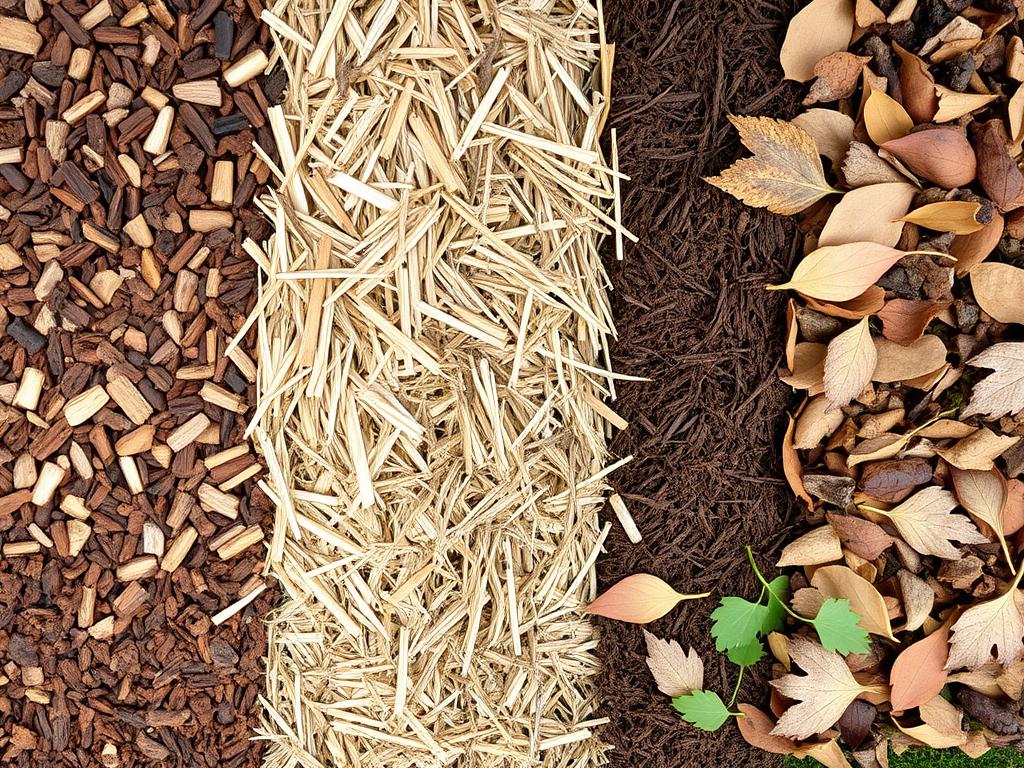
Organic Options
Organic mulches are derived from plant materials and gradually break down over time, adding nutrients to the soil. In arid regions, these mulches can be particularly beneficial for improving soil structure while conserving water.
Wood Chips and Bark
- Water retention: Excellent, can reduce watering by up to 50%
- Longevity: 1-3 years before significant decomposition
- Best for: Trees, shrubs, and perennial beds
- Pros: Slow to decompose, excellent insulation, widely available
- Cons: Can temporarily reduce nitrogen availability as they decompose
Straw and Hay
- Water retention: Very good, especially for vegetable gardens
- Longevity: 3-6 months, breaks down relatively quickly
- Best for: Vegetable gardens and annual beds
- Pros: Inexpensive, lightweight, excellent for suppressing weeds
- Cons: Can contain weed seeds, breaks down quickly in hot climates
Compost
- Water retention: Good, improves soil structure significantly
- Longevity: 3-6 months before fully incorporating into soil
- Best for: Vegetable gardens and annual flower beds
- Pros: Adds nutrients, improves soil biology, readily available
- Cons: Less effective at weed suppression than coarser materials
Leaves and Grass Clippings
- Water retention: Good when properly applied
- Longevity: 2-6 months depending on climate
- Best for: Vegetable gardens and around shrubs
- Pros: Free and readily available, adds nutrients as they decompose
- Cons: Can mat down and become water-repellent if applied too thickly
Inorganic Options
Inorganic mulches don’t decompose and therefore provide long-lasting benefits without needing frequent replacement. In extremely hot, arid climates, these materials can offer specific advantages for water conservation.
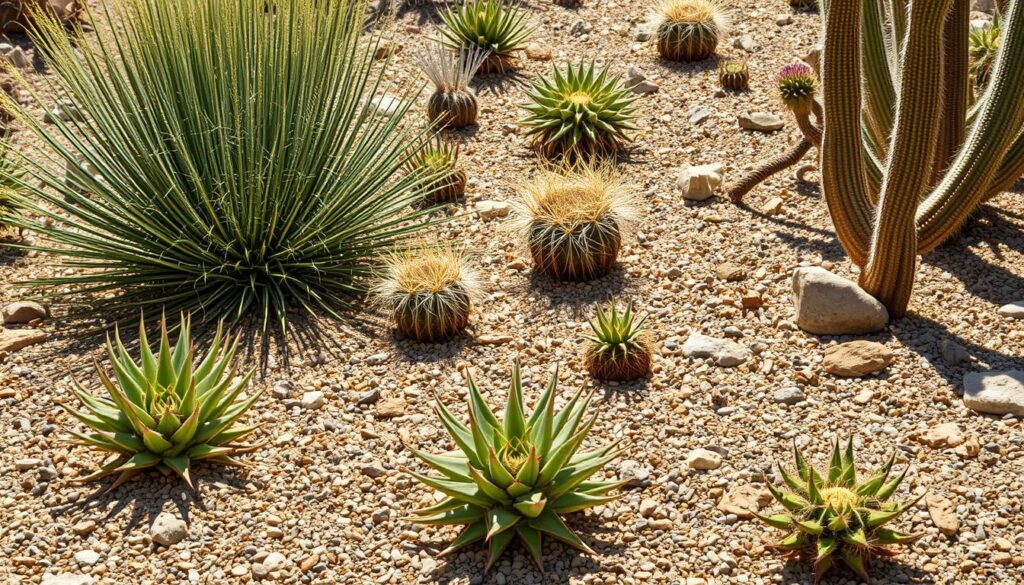
Gravel and Stone
- Water retention: Moderate, reflects heat but prevents evaporation
- Longevity: Permanent, requires occasional cleaning
- Best for: Desert landscapes, succulent gardens, pathways
- Pros: Never needs replacement, excellent drainage, fire-resistant
- Cons: Can heat up significantly, difficult to amend soil later
Landscape Fabric
- Water retention: Good when used under organic mulch
- Longevity: 3-5 years before degrading from UV exposure
- Best for: Under other mulches for enhanced weed control
- Pros: Excellent weed suppression, allows water penetration
- Cons: Can restrict beneficial soil organism movement
Locally Sourced/DIY Mulch Ideas
In arid regions, using locally available materials for mulching can be both economical and environmentally sustainable. These options often require minimal processing and transportation, reducing their environmental footprint.
- Pine needles: Excellent for acid-loving plants, slow to decompose, and form a mat that allows water to penetrate while reducing evaporation
- Crushed nut shells: Pecan, walnut, or almond shells make excellent mulch in regions where these are processed
- Shredded paper: Office paper or newspaper can be shredded and used as mulch, though it should be wetted down to prevent blowing away
- Local plant materials: In desert regions, chipped native plant trimmings can make excellent mulch that’s well-adapted to the climate
“The best mulch is often what’s readily available in your area. Using local materials reduces transportation costs and environmental impact while supporting the natural ecosystem of your region.”
Step-by-Step Mulching Techniques
Proper application of mulch is just as important as choosing the right material. Following these step-by-step techniques will ensure you maximize the water conservation benefits while avoiding common problems.
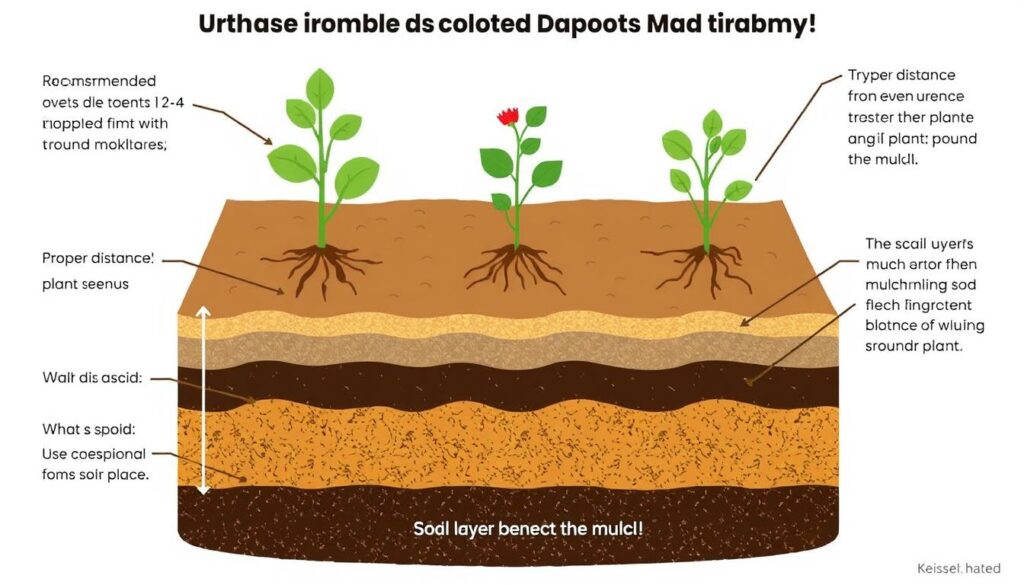
Preparing Soil for Mulch Application
Proper soil preparation before applying mulch ensures maximum water conservation benefits and healthy plant growth. Follow these steps to prepare your soil:
- Remove existing weeds: Clear all weeds from the area, including roots, to prevent them from growing through the mulch layer.
- Water deeply: Before applying mulch, water the soil thoroughly. Mulch is most effective when applied to moist soil, as it helps lock in that initial moisture.
- Add compost if needed: In poor soils, adding a thin layer of compost before mulching can improve soil structure and water retention capacity.
- Level the soil surface: Create a relatively even surface to ensure uniform mulch coverage and prevent water pooling.
- Consider pre-treating for pests: In areas prone to termites or other pests, appropriate preventive measures may be necessary before applying organic mulches.
Layer Thickness Guidelines by Material Type
Different mulch materials require different application depths to provide optimal water conservation benefits while avoiding potential problems. Use these guidelines for various mulch types:
| Mulch Type | Ideal Thickness | Minimum Effective Depth | Maximum Safe Depth | Reapplication Frequency |
| Wood Chips | 3-4 inches | 2 inches | 4 inches | Every 1-2 years |
| Straw/Hay | 4-6 inches | 3 inches | 8 inches | Every 3-6 months |
| Compost | 1-2 inches | 1 inch | 3 inches | Annually |
| Gravel/Stone | 2-3 inches | 1 inch | 4 inches | Every 3-5 years |
| Leaves (shredded) | 2-3 inches | 1 inch | 4 inches | Every 6-12 months |
Avoiding Common Mistakes
Even experienced gardeners can make mistakes when applying mulch. Avoiding these common errors will help maximize water conservation benefits while maintaining plant health:
Do This
- Keep mulch 2-3 inches away from plant stems and tree trunks
- Apply mulch to slightly moist soil, never bone dry
- Extend mulch to the drip line of trees and shrubs
- Replenish mulch as it decomposes or compacts
- Use coarser materials in areas with heavy rainfall
Avoid This
- “Volcano mulching” – piling mulch against tree trunks
- Applying mulch too thinly to be effective
- Using fine mulch in areas prone to heavy rain
- Incorporating fresh wood chips into soil
- Applying mulch over bone-dry soil
Pro Tip: In extremely hot, arid climates, consider using a two-layer mulching approach. Apply a layer of compost directly to the soil, then cover with a coarser material like wood chips. This combination maximizes water retention while improving soil quality over time.
Vertical Garden-Specific Strategies
Vertical gardens and container plants present unique challenges for water conservation. These growing systems typically have limited soil volume and can dry out much faster than in-ground gardens. Effective mulching techniques can dramatically improve water retention in these systems.
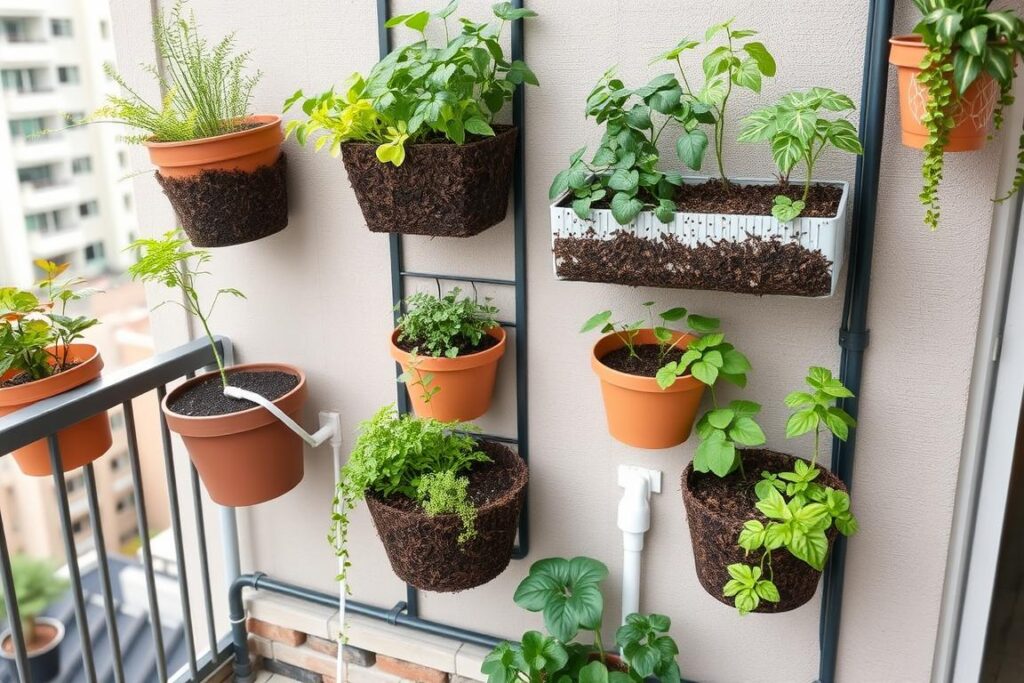
Mulching Container Plants and Raised Beds
Container plants and raised beds have specific mulching requirements that differ from in-ground gardens. These confined growing spaces benefit greatly from proper mulching techniques:
- Use finer materials: In containers, use finer-textured mulches like coco coir, fine compost, or small wood chips that won’t overwhelm the limited space
- Apply thinner layers: Container plants typically need only 1-2 inches of mulch compared to the 3-4 inches used in ground plantings
- Consider mulch mats: Pre-cut mulch mats or discs designed for containers can provide neat, effective coverage
- Leave space at edges: Keep mulch slightly away from the edges of containers to prevent it from spilling over during watering
- Choose lightweight options: For hanging containers or wall-mounted systems, use lightweight mulches like coco coir or rice hulls
Drip Irrigation Integration with Mulch
Combining drip irrigation with proper mulching creates an extremely efficient water conservation system for vertical gardens. Here’s how to integrate these approaches:
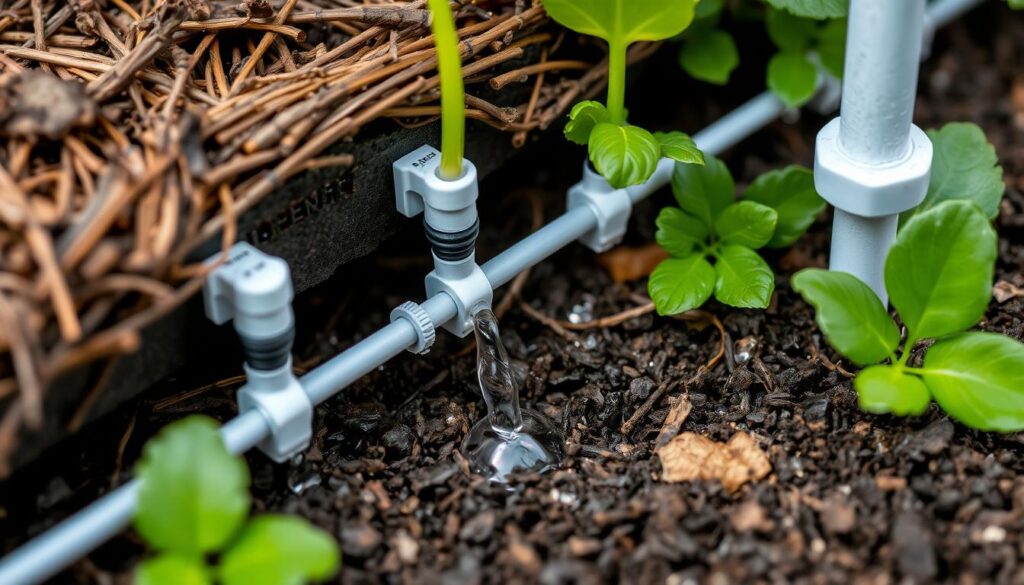
- Install irrigation first: Set up your drip irrigation system before applying mulch
- Position emitters strategically: Place drip emitters near plant roots but not directly against stems
- Apply mulch over lines: Cover irrigation lines with mulch to prevent water evaporation and UV damage to the tubing
- Use pressure-compensating emitters: These ensure even water distribution in vertical systems where height differences create pressure variations
- Monitor effectiveness: Check soil moisture beneath the mulch regularly to fine-tune your irrigation schedule
Case Study: Urban Balcony Garden Example
Maria’s 4th-floor apartment balcony in Phoenix, Arizona, presented extreme challenges for growing vegetables. With summer temperatures regularly exceeding 110°F (43°C) and limited space, she implemented a comprehensive mulching strategy for her vertical garden:
Maria’s Vertical Garden Mulching System
Setup: 8 fabric grow bags and 3 wall-mounted planters in full sun exposure
Challenge: Containers would dry out completely within hours without intervention
Mulching Solution:
- Bottom layer: 1/2 inch of compost directly on soil surface
- Middle layer: 1 inch of coco coir for water retention
- Top layer: 1/2 inch of pebbles in containers receiving the most sun
- Drip irrigation installed beneath all mulch layers
Results: Watering frequency reduced from twice daily to once every 2-3 days, even in peak summer heat. Plant stress significantly reduced and yield increased by approximately 40%.
Vertical Garden Mulching Tip: For wall-mounted planters, consider using a mulch material that won’t easily wash out during watering. Heavier materials like small pebbles or coco coir chunks work well. Alternatively, use mulch mats cut to size that can be secured to the container.
Seasonal Maintenance Tips
Mulch isn’t a “set and forget” solution, especially in arid climates where environmental conditions can quickly degrade or displace mulch materials. Proper seasonal maintenance ensures your mulch continues to provide maximum water conservation benefits year-round.
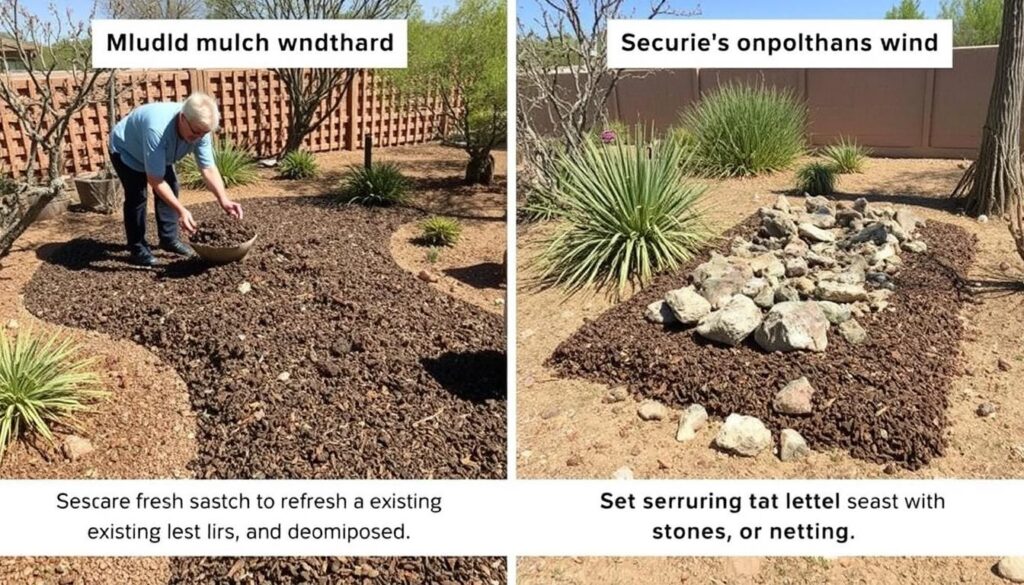
Refreshing Mulch Layers
Over time, organic mulches decompose and inorganic mulches can become compacted or displaced. Regular refreshing maintains their effectiveness:
Spring Maintenance
- Check mulch depth after winter and add more if needed
- Fluff up compacted mulch with a garden fork
- Pull back mulch slightly from emerging perennials
- Remove any moldy sections that developed during winter
Fall Maintenance
- Add fresh mulch before winter to insulate plant roots
- Remove fallen leaves from mulch surface or incorporate them
- Check for pest activity and address before winter
- Ensure proper depth going into the dry season
Combating Wind Displacement
In arid regions, strong winds can quickly displace mulch, reducing its effectiveness for water conservation. These strategies help keep mulch in place:
- Use heavier materials: In windy areas, choose denser mulches like wood chips rather than lighter materials like straw
- Create windbreaks: Strategic placement of plants or structures can reduce wind impact on mulched areas
- Water mulch lightly: A light sprinkling of water can help settle newly applied mulch
- Apply mulch netting: Biodegradable jute netting can hold organic mulches in place until they settle
- Edge garden beds: Creating a physical barrier around mulched areas helps contain materials
Monitoring Soil Moisture Levels
Even with mulch in place, it’s essential to monitor soil moisture regularly, especially in arid climates where conditions can change rapidly. Proper monitoring ensures plants receive adequate water without waste:
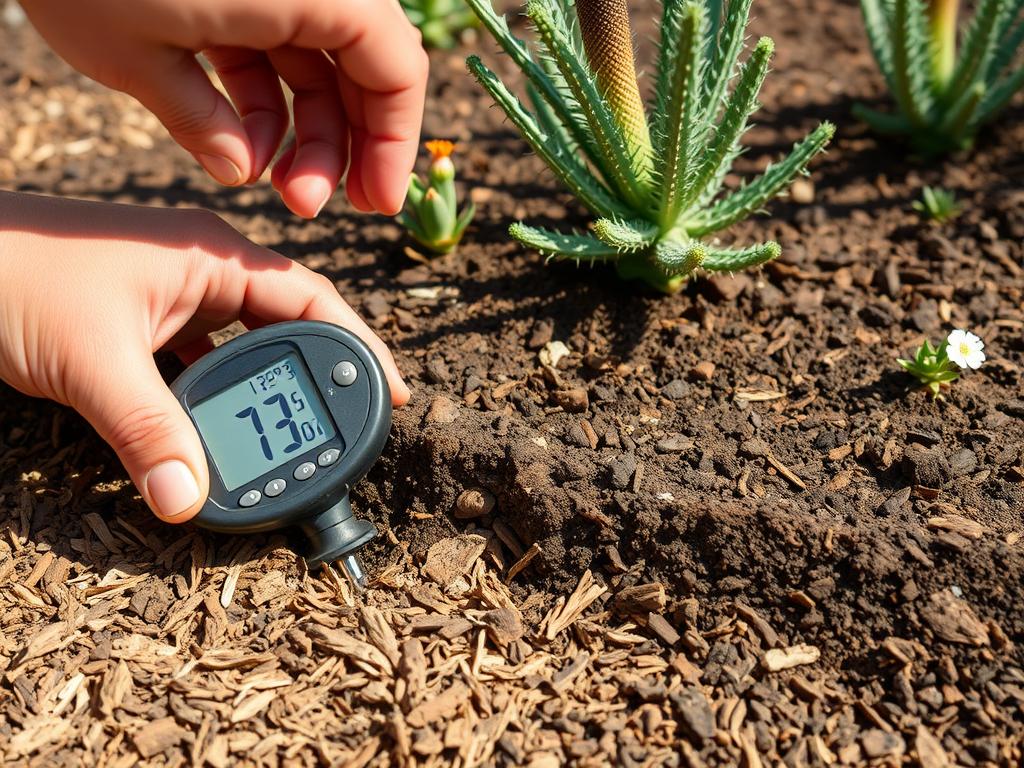
Manual Checking Methods
- Finger test: Gently push aside mulch and insert your finger 2-3 inches into the soil to feel for moisture
- Soil probe: Use a soil probe or narrow trowel to extract a small soil sample from beneath the mulch
- Visual inspection: Look for color changes in the soil that indicate moisture levels
Technology-Assisted Methods
- Moisture meters: Affordable probes that give immediate readings of soil moisture
- Smart irrigation controllers: Systems that adjust watering based on soil moisture sensors
- Moisture sensor stakes: Devices that change color or provide digital readings of soil moisture
Important: In arid climates, soil beneath mulch can sometimes appear moist on the surface while being dry at root level. Always check moisture at the depth where most active roots are growing, typically 3-6 inches below the surface.
Ready to take your water conservation to the next level?
Download our free seasonal mulch maintenance calendar customized for arid climate gardeners. Get month-by-month reminders and tips to keep your garden thriving with minimal water use.
Conclusion
Implementing effective mulching techniques is one of the most impactful steps you can take to conserve water in arid climate gardens. By creating a protective barrier that reduces evaporation, regulates soil temperature, and improves soil structure, mulch transforms the growing environment and dramatically reduces water requirements.
The key takeaways from this guide include:
- Choose mulch materials appropriate for your specific gardening situation, considering factors like climate, plant types, and aesthetic preferences
- Apply mulch at the correct depth—typically 2-4 inches for most organic materials—to maximize water conservation benefits
- Maintain proper distance between mulch and plant stems to prevent disease and pest issues
- Integrate mulching with other water-wise practices like drip irrigation for maximum efficiency
- Regularly maintain and refresh mulch layers to ensure continued effectiveness
As climate patterns continue to shift and water becomes an increasingly precious resource, these mulching techniques for water conservation will only grow in importance. By implementing these strategies in your garden—whether it’s a vertical setup on a balcony or a traditional in-ground plot—you’re not only creating a more resilient growing environment but also contributing to broader water conservation efforts.
Remember that successful water-wise gardening is about creating systems that work together. Mulching is most effective when combined with appropriate plant selection, efficient irrigation, and ongoing soil improvement. With these integrated approaches, even gardens in the most challenging arid environments can thrive while minimizing water use.
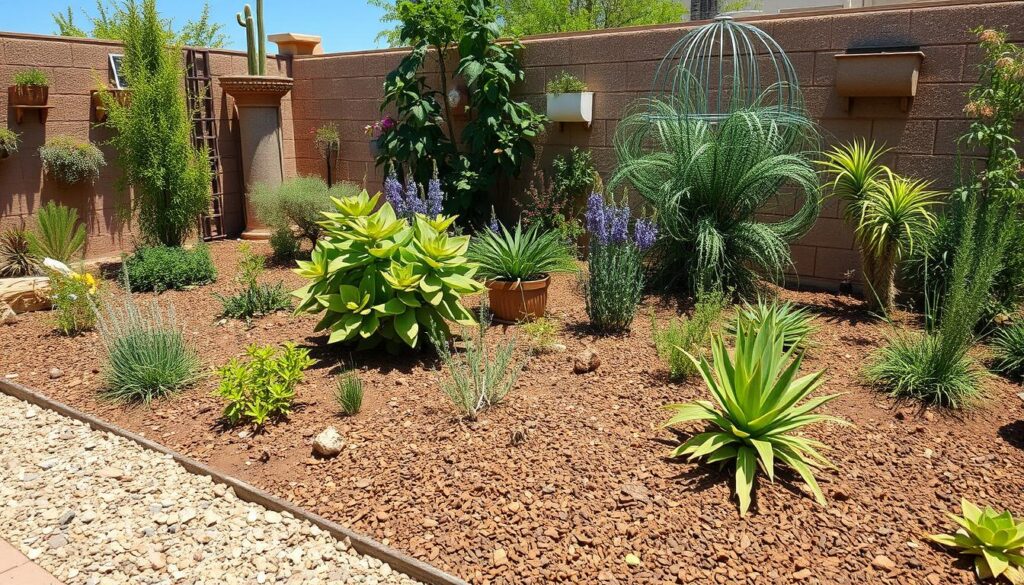
Frequently Asked Questions
Can I use mulch in all types of gardens?
Yes, mulch can be beneficial in virtually all garden types, from traditional in-ground beds to raised beds, containers, and vertical gardens. The key is selecting the appropriate mulch material and application depth for your specific situation. For container and vertical gardens, use finer materials and thinner layers (1-2 inches) compared to in-ground applications (3-4 inches).
How much water can mulching actually save?
Studies have shown that proper mulching can reduce water needs by 25-50% in arid climates. The exact savings depend on factors like climate severity, mulch type and depth, soil composition, and plant selection. Many gardeners report being able to reduce irrigation frequency from daily to once every 3-4 days after implementing effective mulching techniques.
Will mulch attract pests to my garden?
When properly applied, mulch should not significantly increase pest problems. However, certain practices can minimize potential issues: keep mulch at least 2-3 inches away from plant stems and building foundations, avoid excessive thickness (no more than 4 inches), and use cedar or cypress mulches which naturally repel some insects. If termites are a concern in your area, consider using gravel or stone mulches near structures.
How often should I replace or refresh my mulch?
Organic mulches break down at different rates depending on climate and material. In arid regions: wood chips typically need refreshing every 1-2 years; straw and leaves every 3-6 months; and compost every 6-12 months. Rather than removing old mulch, simply add a thin new layer on top when the existing mulch has decomposed to less than half its original depth. Inorganic mulches like gravel may only need occasional cleaning or redistribution.
Can I use mulch for newly planted seeds?
For direct-seeded areas, wait until seedlings are established before applying mulch. Premature mulching can block light and create a physical barrier that prevents germination. Once seedlings are 2-3 inches tall, carefully apply a thin layer of fine-textured mulch like compost or fine straw around (not over) the plants. Gradually increase mulch depth as plants grow larger.
Will is a vertical gardening enthusiast and sustainable cultivation specialist with a passion for helping people grow fresh food in small spaces and dry climates. With years of hands-on experience testing smart irrigation systems, optimizing urban gardens, and exploring eco-friendly solutions, this author shares clear, practical tips to turn any corner into a productive garden. Whether on a sunny balcony or in a compact backyard, Will helps readers save water, maximize space, and enjoy healthy harvests year-round. When not tending to his plants, you’ll find him sipping herbal tea and sketching ideas for new sustainable projects.

